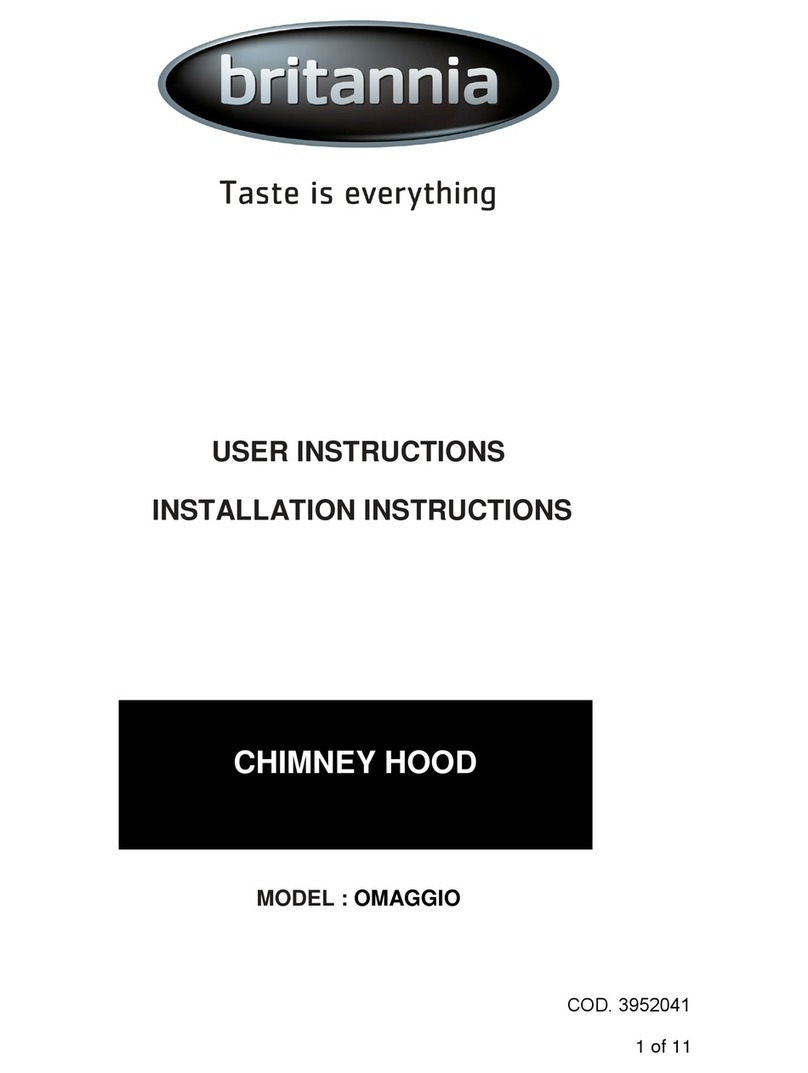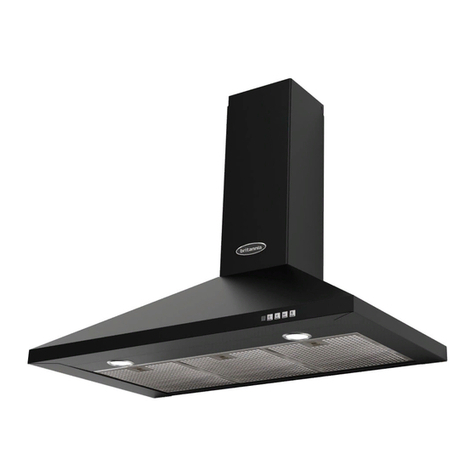Core Colour Brown Blue Green/Yellow
4.4. Connecting the Ducting
Terminate the ducting where it exits the building. If using a wall
mount weather louvre secure the ducting to the louvre spigot and
attach the louvre to the wall. Ensure that the air fins are directed
downwards. If you are fitting an alternative termination ensure that
the ducting is secure.
If using expanding foam make sure that any flexible ducting is
supported internally to prevent it crushing or use rigid ducting
through the wall where foamed.
Pull any flexible ducting back along its route such that it is as
smooth as possible. Position the extractor face down and as close
to the opening as is practical and cut off excess before connecting
the ducting to the extractor exhaust spigot(s) using plastic tie
straps or a suitable alternative (e.g. jubilee clip).
Secure the louvre to the outside wall. Ensure that any air fins are
directed downwards.
Check that the duct has not been flattened or kinked.
4.5. Fixing the Extractor in position.
Fixing the extractor safely into position requires two people so do not start
if assistance is unavailable.
Remove the grease filters as described in Section 10.
The extractor is held securely in place by 4 adjustable spring
toggles (only visible on the outer casing of the unit).
Screws for adjusting the height of each spring toggle are located
behind the grease filters on the outer filter housing flange (see
Figure 1). The spring toggles are moved up by turning the screws
anti-clockwise and down by turning clockwise.
Ensure that each spring toggle height is set such that when pushed
from outside it moves freely and fully into the outer casing of the
unit and when slowly released returns to an open position just
below the top of the spring toggle slot. The spring toggle should
protrude from the casing by at least 8mm (see Figure 1).
Suplementary support of the unit is provided by sprung safety clips
which are intended to hold the unit safely in place during removal
(see later). The safety clips (See Figure 1) should be disabled for
installation by pulling the clip release into the body until the clip
latch is clear of it’s slot and then sliding to one side so that the clip
latch rests against the inner casing of the unit.
Check that the electrical supply chord has been connected, that
power is switched off and that the ducting is securely fastened to
the spigot. Check, if applicable, that any external fans are plugged
into the unit.
Push the extractor up through the prepared opening until the spring
toggles are heard to snap over the edge of the opening –we
recommend that two people do this supporting one end of the
extractor each. Carefully release the unit ensuring that it is
supported within the opening by all four spring toggles. If a spring
toggle fails to catch try pushing upwards again and if this fails
remove the unit as described later and check the panel thickness
and setting of the spring toggles as described earlier.
Re-enable the two sprung safety clips by once again pulling the
safety clip release (Figure 1.) and sliding the clip latch back into the
slot from which it was earlier withdrawn. The clip latch should pass
fully through the outer casing.
Close up any gaps between the soffit panel and the units outer
flange (often referred to as the fixing flange) by turning the spring
toggle adjustment screws clockwise. If the gap is larger that 1-2mm
then this should be done in stages of approximately 1mm, working
your way around each of the four adjustment screws in turn until the
unit has been pulled up into position.
Note: Ideally, although not always possible, access to the ducting
should be provided for when the unit is in place, for straightening
the duct following installation, inspection and future repair work.
5. REMOVING THE CANOPY HOOD
First remove the grease filters and ensure that the sprung safety
clip is correctly set. Only the clip release grip and mounting arm
should be on the inside of the unit (as in Figure 1) with the latch fully
through the slot in the hood casing. If in doubt pull the clip release
to reveal the clip latch and make sure that it passes fully back
through the casing when released.
With the safety clips correctly set turn the spring toggle adjustment
screws anti-clockwise. The extractor will gradually start to lower.
This is best done in stages, working your way around the 4 screws
thus lowering the unit evenly and avoiding undue stress on any one
spring toggle. Note: as you turn the adjustment screws the spring
toggles gradually rise until they reach the top of their slots after
which they start to retract into the hood casing.
You will know when the spring toggles start to retract because the
hood will start to rise up slightly into the soffit rather than lower.
When this happens you should support the extractor and continue
to turn the screws carefully clockwise. When the spring toggles
have retracted sufficently the unit will lower once again - this will
happen suddenly if you are not supporting the hood.
The sprung safety clips are there to catch the unit and to prevent it
falling from the opening in the soffit should you let go of the hood. If
you do need to let go of the hood then do so carefully, ensuring that
the safety clips have indeed trapped the unit in the opening before
letting go of the hood. This is a supplementary support system
intended to lessen the risk of dropping the unit and, when correctly
engaged, to provide momentary support.
Two people are required to lower the unit safely. The unit is
released for final lowering by each person pulling the safety clip
release into the body whilst supporting the unit with their other
hand. When the clips are pulled into the body the spring latch will
disengage from the soffit and the unit can be lowered.
ELECTRICAL HAZARD
DISCONNECT ELECTRICAL SUPPLY
BEFORE PROCEEDING FURTHER



























